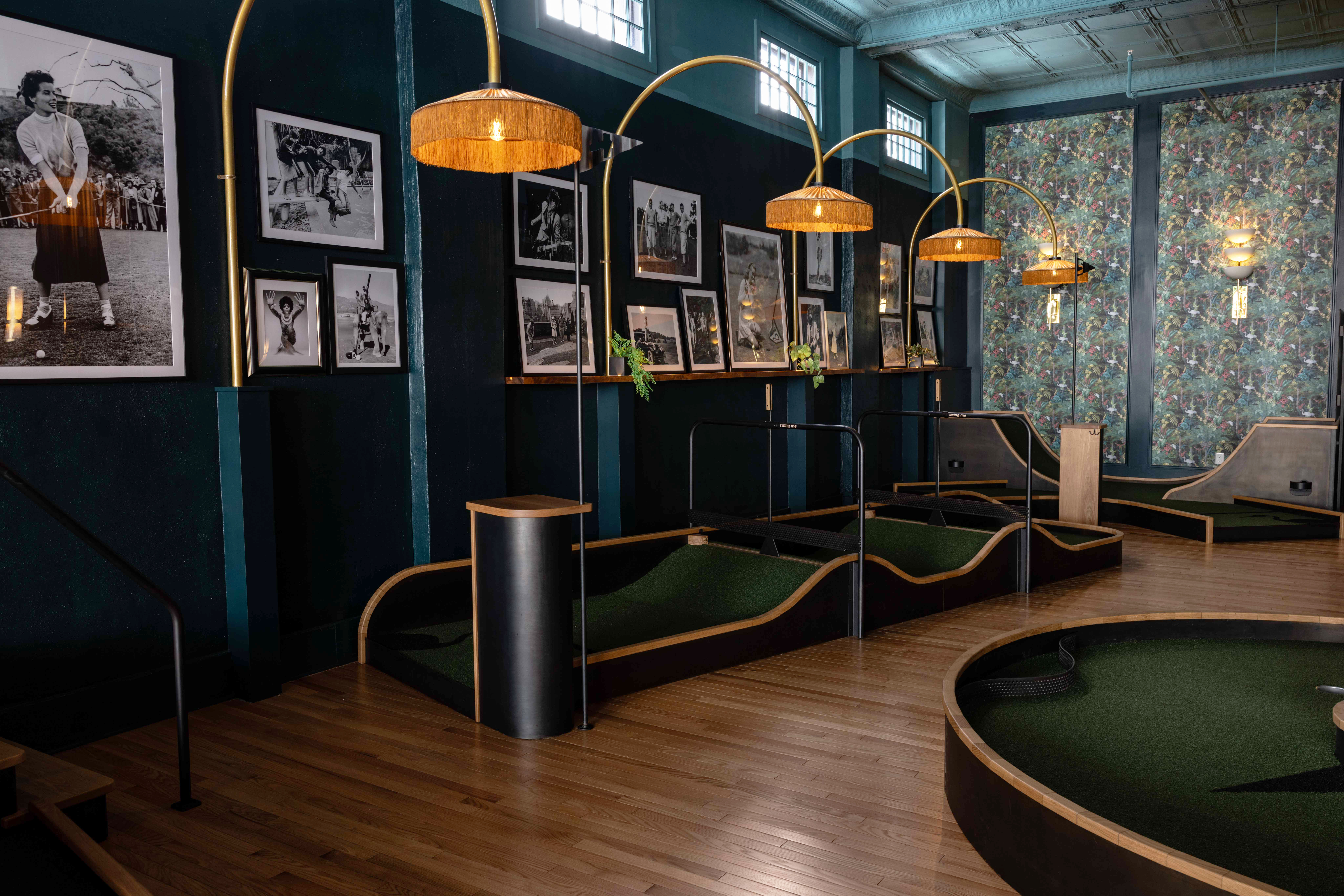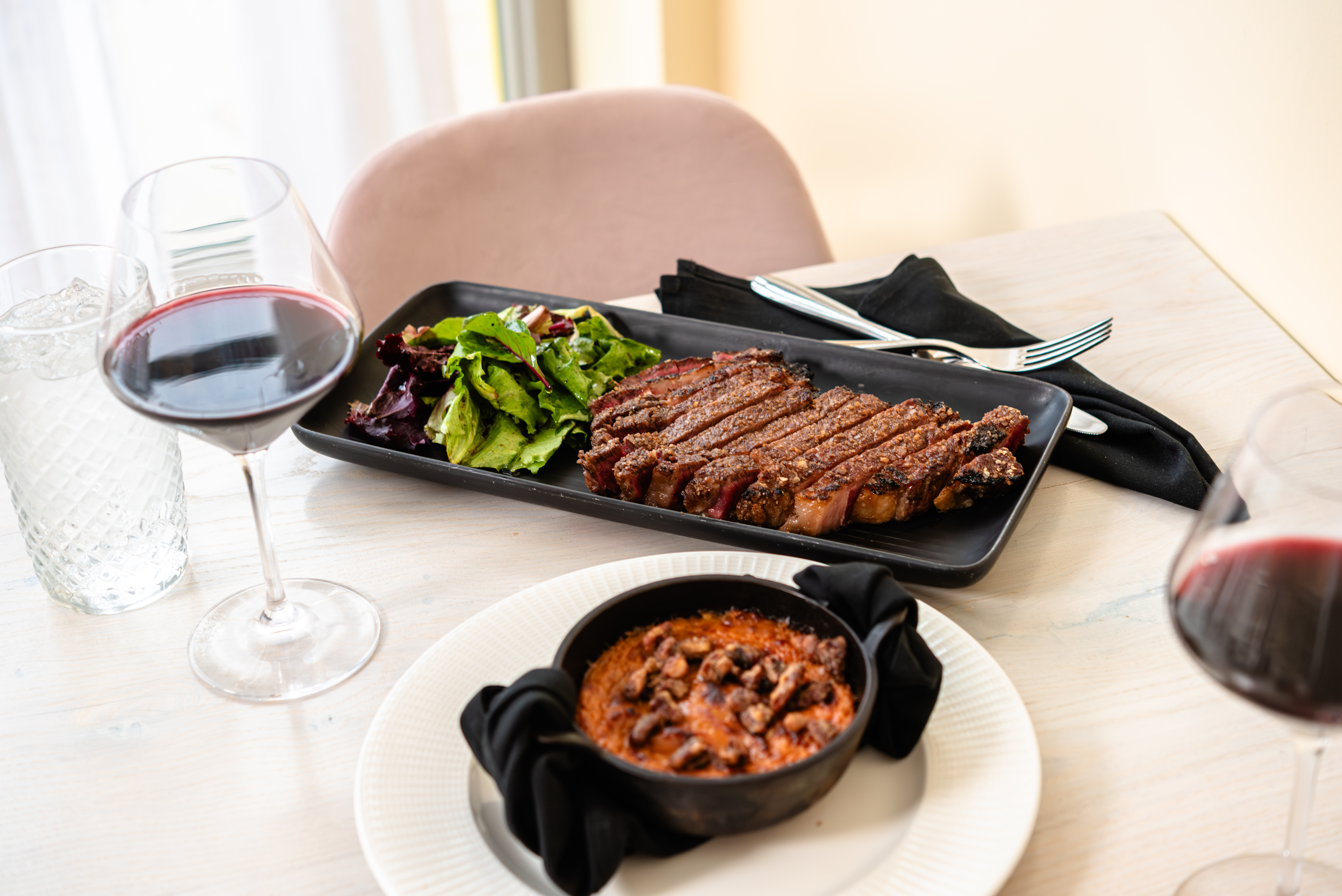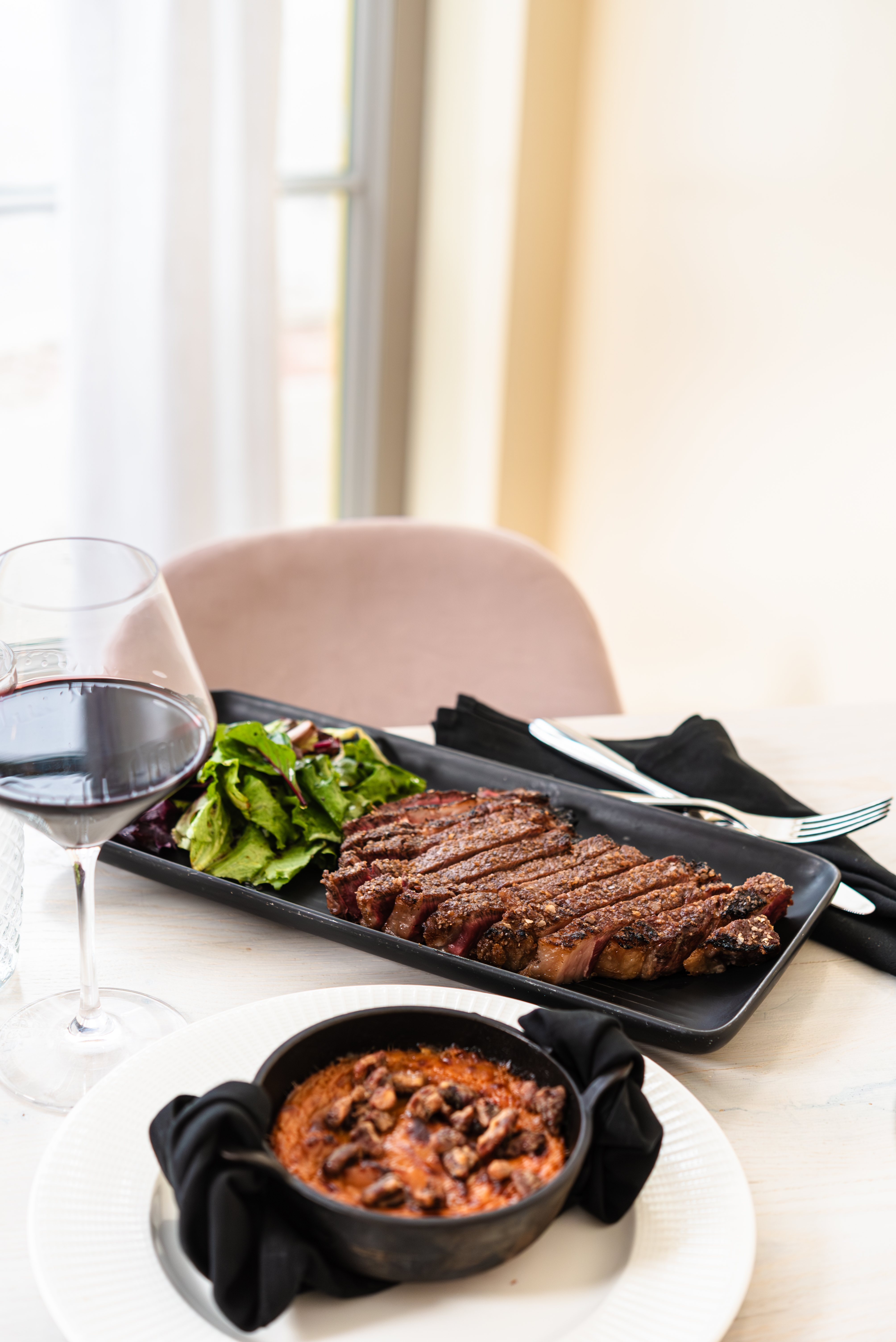There is little more than an hour to go until the first guests arrive, and nearly a dozen men and women crowd around two pushed-together tables in Trentina's tiny white-brick dining room. The mirrored, gilded tables are overflowing with dishes, from a long, narrow plate painted with delicately rolled lox, carefully smeared cream cheese and precisely affixed capers to a shallow bowl cradling five speckknoedel (Austrian bacon dumplings) bathing in broth. The front-of-house employees at Jonathon Sawyer's University Circle gem have gathered, some on their day off, to listen and learn — and to eat.
Throughout the staff meeting, nearly everyone asks questions as each new dish is introduced: Where is quinoa grown? (The Andes.) Is the yogurt house-made? (Yes.) Isn't there something kind of special about hickory nuts? (They must be hand-shelled.)
In this hour, Trentina feels more like a classroom than a dining room. And judging by the depth of most of the queries, the servers are as much students as they are experts.
This is no ordinary restaurant, and Jonathan Sawyer is no ordinary leader. His contribution to Cleveland's ascension in the culinary arena includes the Greenhouse Tavern and Noodlecat, not to mention numerous appearances on Food Network and more than a few awards. But if you think you know his work, Trentina will turn your preconception on its pig's head.
The eagerly awaited opening of Trentina was heralded like the second coming of Michael Symon, splashed across the pages of Esquire, Food & Wine and Huffington Post.
The restaurant's Menu Bianco, a 12-course, $115 tasting menu, will not fit every Clevelander's tastes. The portions are precious, the pace leisurely and the flavors oftentimes unfamiliar. For instance, the primo assaggio, or "first taste," consists of various house-cured meats, fermented vegetables and polenta crisps spread with cultured butter. There's a beef suet candle served with bread and foraged sumac powder. Later served in the meal is a wild mushroom course that's lightly smoked just before hitting the table, then covered with an inverted dish to capture the vapors. It's the kind of food that some humble Midwesterners might disparagingly call "fussy."
Except when you stop to really examine what's going on behind the scenes here, it's about much more than celebrity chefdom and avant-garde foodie-ism.
Trentina takes diners out of their comfort zones with tastes and textures — artistry on the plate — as yet unmatched in this city.
"It's just the way that it works when your mind gets into a place where you've gotten beyond the place of knowledge and you're into the place of creativity," says Sawyer.
Trentina was inspired by and named for the Austrio-Italian region of Trento, where Sawyer's wife Amelia's family originates. The Sawyers traveled there to learn about the food. But what they brought back wasn't a new technique or product. Rather, it was a philosophy, one that requires a deeper connection to our own backyards to form more meaningful culinary traditions of our own.
As Cleveland forges its identity as an epicenter of food, there are also signs of a new kind of confidence in our city's trendsetting abilities. New York, Chicago and San Francisco have their fingers on the pulse of American cuisine, but they're not alone. "We can actually tell other cities what's popular," he says.
So, sure, there's pasta on the menu. And yes, it's largely in Italian. But many of the ingredients on the Menu Bianco and elsewhere in the restaurant (there are rotating a la carte and brunch menus) are more than local to Northeast Ohio — they're actually native. Sumac and chickweed, boletes and watercress: Sawyer even employs a forager, who last year identified 173 edible local species and expects to double that number in 2015.
For example, Trentina served seven varieties of local chanterelle mushrooms last year, a feat unmatched by other high-end restaurants that must purchase these delicacies from the Pacific northwest, where most commercial harvesting occurs. Sweeter mushrooms were paired with apricot and dehydrated chanterelle sugar, while earthier ones accompanied veal and chickpea gastrique.
An outbuilding just a dozen steps from the restaurant's back door provides extra room for a walk-in cooler, equipment storage, several baking ovens and a comparatively roomy prep space. High up on the walls is a shelf lined with glass jars of locally grown tomatoes, which took the staff about a month to can.
"We take all of their peels and dehydrate those and incorporate them into a butter," Sawyer says. He uses the butter in the restaurant's tomato bucatini, which partly composes the pasta alla chitarra, the stunning seventh course of the Menu Bianco. The staple has remained little changed since opening day in July, despite the monthly overhaul of most of the rest of the menu.
In its most essential form, it's pasta in a tomato-butter sauce. But the flavor, the obvious effort behind each ingredient's preparation, the unique presentation and the story behind its conception elevate it.
The back of the house begins the dance of a Saturday-night service to the sounds of an eclectic playlist and the clinking and hum of conversation from the dining room. The grill cook shows off his spoon-twirling skills while answering "Would you rather" hypotheticals thrown out from other cooks. It shows that these guys don't take themselves too seriously.
"And if a plate ever looks too fancy," Sawyer laughs, "then we just plate it with our left hand."
When You Go
Trentina
TRY THIS: The mountainous terroir of the Trento region is perfectly suited for growing grapes. Any one of the half-dozen or so options on the wine list is a safe bet, from a bright, mineral-forward chardonnay ($40/bottle) to a surprisingly light but complex teroldego ($13/glass). GOOD TO KNOW: Be sure to check out the two upstairs bathrooms, which feature beautiful 1970s vintage wallpaper and heated seats with various bidet settings on the ultramodern toilets.
Trentina's forager Jeremy Umansky shares his favorite local species.
Field Notes from a Forager
Since opening at the beginning of July, Trentina has served more than 70 species of wild fungi and nearly 180 wild plants. The restaurant's chefs then used these ingredients to make nearly 400 different recipe components, says Jeremy Umansky, forager and larder master at Trentina. Umansky shares how to use his favorite plants that you can find in your own backyard pantry.
Milkweed, Asclepias syriaca
Milkweed is one of my favorite plants. It's native to our area, is a sign of a sound, stable and healthy ecosystem, has a long growing season, regenerates quickly when harvested and provides us with five unique vegetables. At Trentina, we use the young shoots in the early spring; the leaves in spring, summer, and fall; the unopened flower heads in early summer; the flowers in late summer; and the seed pods in early fall. Milkweed lends itself to a myriad of techniques in the kitchen, from raw applications to blanching to sauteing to grilling. Its flavor is slightly reminiscent of a cross between broccoli and asparagus.
Chanterelles, Cantharellus spp. (specifically Cantharellus cibarius)
Nothing says summer like a sun-drenched chanterelle. The flavor of chanterelles is often described as a mashup of savory mushrooms, sun-kissed apricots and toasted black peppercorn. Chanterelles are a mycorrhizal fungi. This means that they live symbiotically with a host. Due to this relationship, the fungus doesn't solely rely on sporulating to reproduce and grow. It can spread just as easily from its underground network of roots known as mycelium. This in turn means that overharvesting isn't as much of a concern as it is with species that rely on a finite amount of organic matter to live. Chanterelles can flush, or appear, for months in our area in obscene numbers. It's not uncommon for me to harvest 50 pounds in an afternoon.
Shagbark Hickory, Carya ovate
Shagbark Hickory is a majestic sky-touching tree native to the eastern part of the United States. It can grow to a towering 150 feet and live in excess of 300 years. Shagbark gives us several items that we use in our kitchen. We cook most of our food at Trentina over a wonderfully smoky hardwood fire. Shagbark provides us with a continual supply of wood that we can obtain without harming the tree. As its name implies, Shagbark Hickory has shaggy bark. As the tree grows, its outer layer of bark peels away in large strips and falls to the ground. This is the wood we use to smoke many of the smoked foods we create at Trentina. Shagbark hickory also produces a nut that rivals both walnuts and pecans. The final product that we use from this tree is its sap. We use it straight from the tree as a component in many items both sweet and savory. The sap also gets cooked down just as maple sap does and is turned into fantastically earthy and smoky syrup.
Boletes, Boletus spp., Tylopilus spp., Leccinum spp., Suilus spp., and Gyroporus spp.
Boletes are one of most varied and populous mushrooms in our area. Most of us are only familiar with Boletus edulis, commonly known as the king bolete, cep or porcini. While its reputation as the king of mushrooms is well-deserved, it is far from being the only delicious bolete. Amongst the five above-mentioned genus, we have served nearly 30 species of these scrumptious fungi. Like chanterelles, boletes are virtually all mycorrhizal and are somewhat tolerant to being generously harvested. At Trentina, we use them fresh, dry them, ferment them, salt-cure them and autolyse extracts made from them [a process that uses the plant's own enzymes to break down cells into savory amino acids]. One of my personal favorites is Gyroporus castaneus, commonly known as the chestnut bolete. This tiny, hard-to-find bolete has a texture and flavor that reminds me of my favorite Cape Cod oyster, the Beach Point.
Wild Rose, Rosa spp. (specifically Rosa virginiana)
Wild roses grow everywhere in Northeastern Ohio — and I mean everywhere. From roadsides and abandoned lots to forests and meadows, you'll find an abundance of this delightful naturalized edible. While most of us can easily pick out roses at a market or florist, wild roses will leave you second-guessing. The flowers themselves look as far-removed from cultivated varieties as an apple from an orange. At Trentina, we use the flowers and the rose hips. The hips are by far my favorite part of this plant. They are high in vitamin C, brilliantly red in color and have a fruity flavor. We cure them in sugar, turn them into sorbetto, use them fresh and brew them into sauces and tisanes [herbal teas].
Trending
-
1
-
2
-
3
-
4
-
5










